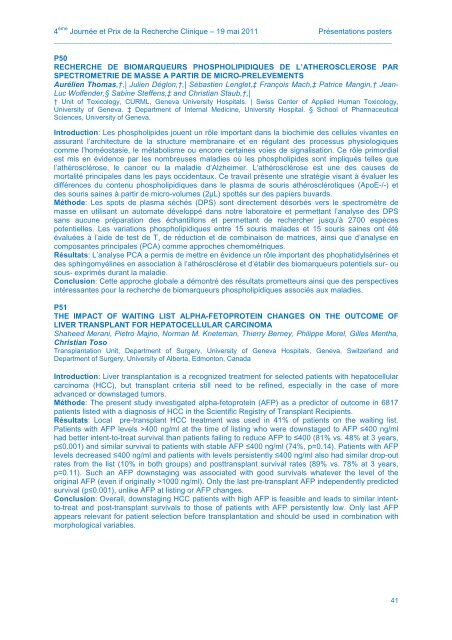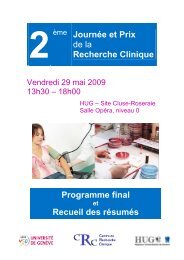Programme final et Recueil des résumés - Centre de recherche ...
Programme final et Recueil des résumés - Centre de recherche ...
Programme final et Recueil des résumés - Centre de recherche ...
Create successful ePaper yourself
Turn your PDF publications into a flip-book with our unique Google optimized e-Paper software.
4 ème Journée <strong>et</strong> Prix <strong>de</strong> la Recherche Clinique – 19 mai 2011 Présentations posters<br />
________________________________________________________________________________<br />
P50<br />
RECHERCHE DE BIOMARQUEURS PHOSPHOLIPIDIQUES DE L’ATHEROSCLEROSE PAR<br />
SPECTROMETRIE DE MASSE A PARTIR DE MICRO-PRELEVEMENTS<br />
Aurélien Thomas,†,| Julien Déglon,†,| Sébastien Lengl<strong>et</strong>,‡ François Mach,‡ Patrice Mangin,† Jean-<br />
Luc Wolfen<strong>de</strong>r,§ Sabine Steffens,‡ and Christian Staub,†,|<br />
† Unit of Toxicology, CURML, Geneva University Hospitals. | Swiss Center of Applied Human Toxicology,<br />
University of Geneva. ‡ Department of Internal Medicine, University Hospital. § School of Pharmaceutical<br />
Sciences, University of Geneva.<br />
Introduction: Les phospholipi<strong><strong>de</strong>s</strong> jouent un rôle important dans la biochimie <strong><strong>de</strong>s</strong> cellules vivantes en<br />
assurant l’architecture <strong>de</strong> la structure membranaire <strong>et</strong> en régulant <strong><strong>de</strong>s</strong> processus physiologiques<br />
comme l’homéostasie, le métabolisme ou encore certaines voies <strong>de</strong> signalisation. Ce rôle primordial<br />
est mis en évi<strong>de</strong>nce par les nombreuses maladies où les phospholipi<strong><strong>de</strong>s</strong> sont impliqués telles que<br />
l’athérosclérose, le cancer ou la maladie d’Alzheimer. L’athérosclérose est une <strong><strong>de</strong>s</strong> causes <strong>de</strong><br />
mortalité principales dans les pays occi<strong>de</strong>ntaux. Ce travail présente une stratégie visant à évaluer les<br />
différences du contenu phospholipidiques dans le plasma <strong>de</strong> souris athérosclérotiques (ApoE-/-) <strong>et</strong><br />
<strong><strong>de</strong>s</strong> souris saines à partir <strong>de</strong> micro-volumes (2µL) spottés sur <strong><strong>de</strong>s</strong> papiers buvards.<br />
Métho<strong>de</strong>: Les spots <strong>de</strong> plasma séchés (DPS) sont directement désorbés vers le spectromètre <strong>de</strong><br />
masse en utilisant un automate développé dans notre laboratoire <strong>et</strong> perm<strong>et</strong>tant l’analyse <strong><strong>de</strong>s</strong> DPS<br />
sans aucune préparation <strong><strong>de</strong>s</strong> échantillons <strong>et</strong> perm<strong>et</strong>tant <strong>de</strong> <strong>recherche</strong>r jusqu’à 2700 espèces<br />
potentielles. Les variations phospholipidiques entre 15 souris mala<strong><strong>de</strong>s</strong> <strong>et</strong> 15 souris saines ont été<br />
évaluées à l’ai<strong>de</strong> <strong>de</strong> test <strong>de</strong> T, <strong>de</strong> réduction <strong>et</strong> <strong>de</strong> combinaison <strong>de</strong> matrices, ainsi que d’analyse en<br />
composantes principales (PCA) comme approches chemométriques.<br />
Résultats: L’analyse PCA a permis <strong>de</strong> m<strong>et</strong>tre en évi<strong>de</strong>nce un rôle important <strong><strong>de</strong>s</strong> phophatidylsérines <strong>et</strong><br />
<strong><strong>de</strong>s</strong> sphingomyélines en association à l’athérosclérose <strong>et</strong> d’établir <strong><strong>de</strong>s</strong> biomarqueurs potentiels sur- ou<br />
sous- exprimés durant la maladie.<br />
Conclusion: C<strong>et</strong>te approche globale a démontré <strong><strong>de</strong>s</strong> résultats prom<strong>et</strong>teurs ainsi que <strong><strong>de</strong>s</strong> perspectives<br />
intéressantes pour la <strong>recherche</strong> <strong>de</strong> biomarqueurs phospholipidiques associés aux maladies.<br />
P51<br />
THE IMPACT OF WAITING LIST ALPHA-FETOPROTEIN CHANGES ON THE OUTCOME OF<br />
LIVER TRANSPLANT FOR HEPATOCELLULAR CARCINOMA<br />
Shaheed Merani, Pi<strong>et</strong>ro Majno, Norman M. Kn<strong>et</strong>eman, Thierry Berney, Philippe Morel, Gilles Mentha,<br />
Christian Toso<br />
Transplantation Unit, Department of Surgery, University of Geneva Hospitals, Geneva, Switzerland and<br />
Department of Surgery, University of Alberta, Edmonton, Canada<br />
Introduction: Liver transplantation is a recognized treatment for selected patients with hepatocellular<br />
carcinoma (HCC), but transplant criteria still need to be refined, especially in the case of more<br />
advanced or downstaged tumors.<br />
Métho<strong>de</strong>: The present study investigated alpha-f<strong>et</strong>oprotein (AFP) as a predictor of outcome in 6817<br />
patients listed with a diagnosis of HCC in the Scientific Registry of Transplant Recipients.<br />
Résultats: Local pre-transplant HCC treatment was used in 41% of patients on the waiting list.<br />
Patients with AFP levels >400 ng/ml at the time of listing who were downstaged to AFP ≤400 ng/ml<br />
had b<strong>et</strong>ter intent-to-treat survival than patients failing to reduce AFP to ≤400 (81% vs. 48% at 3 years,<br />
p≤0.001) and similar survival to patients with stable AFP ≤400 ng/ml (74%, p=0.14). Patients with AFP<br />
levels <strong>de</strong>creased ≤400 ng/ml and patients with levels persistently ≤400 ng/ml also had similar drop-out<br />
rates from the list (10% in both groups) and posttransplant survival rates (89% vs. 78% at 3 years,<br />
p=0.11). Such an AFP downstaging was associated with good survivals whatever the level of the<br />
original AFP (even if originally >1000 ng/ml). Only the last pre-transplant AFP in<strong>de</strong>pen<strong>de</strong>ntly predicted<br />
survival (p≤0.001), unlike AFP at listing or AFP changes.<br />
Conclusion: Overall, downstaging HCC patients with high AFP is feasible and leads to similar intentto-treat<br />
and post-transplant survivals to those of patients with AFP persistently low. Only last AFP<br />
appears relevant for patient selection before transplantation and should be used in combination with<br />
morphological variables.<br />
41






